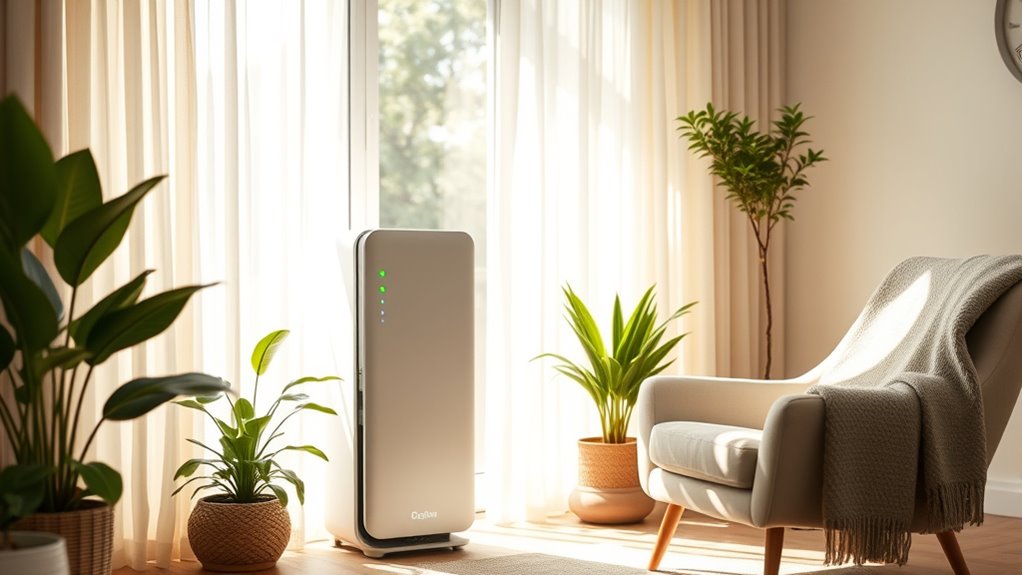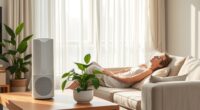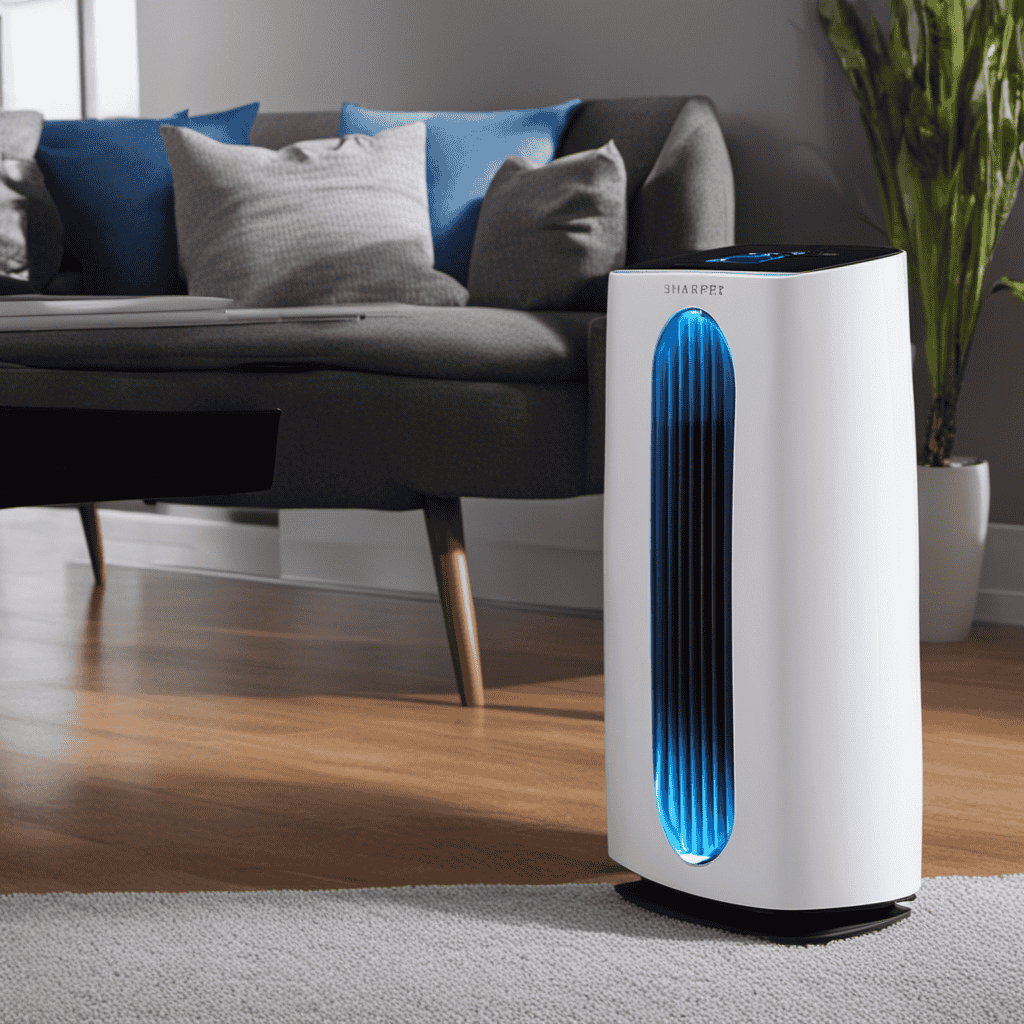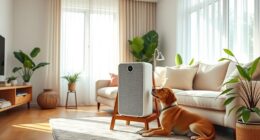If you have chemical sensitivity or MCS, air purifiers can really help by removing airborne chemicals, VOCs, and odors from your indoor environment. Look for models with activated carbon filters and advanced technologies like photocatalytic oxidation, which trap and neutralize chemicals rapidly. Proper placement and regular maintenance keep your purifier working effectively. Using these tools along with lifestyle changes can considerably reduce exposure and improve your comfort—discover more ways to create a safer, healthier space.
Key Takeaways
- Air purifiers remove airborne chemicals like VOCs and vapors, reducing triggers for chemical sensitivities.
- Activated carbon filters adsorb chemical pollutants, improving indoor air quality for sensitive individuals.
- Proper placement and maintenance of purifiers ensure effective removal of chemical particles and odors.
- Combining HEPA and activated carbon filters provides comprehensive protection against particles and chemical vapors.
- Using air purifiers alongside other strategies minimizes exposure and alleviates symptoms of chemical sensitivities.
Understanding Multiple Chemical Sensitivity and Its Effects
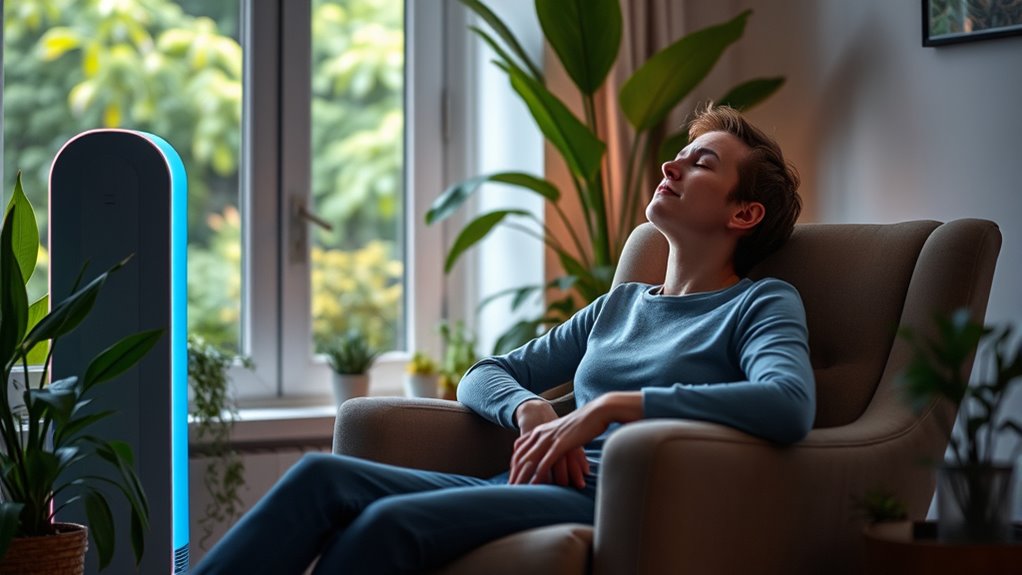
Multiple Chemical Sensitivity (MCS) is a condition where your body reacts negatively to common chemicals found in everyday products, such as perfumes, cleaning supplies, and air fresheners. Industrial pollutants, like emissions from factories and vehicles, often contribute to these sensitivities, making the environment more challenging. Household cleaners, though essential, release chemicals that can trigger symptoms, especially if your body struggles to detoxify or adapt. When exposed to these substances, you might experience headaches, fatigue, or respiratory issues. MCS is complex because it varies from person to person, but understanding that these chemicals can accumulate and cause symptoms is key. Recognizing the role of industrial pollutants and household cleaners helps you take steps to reduce exposure and manage your sensitivity effectively. Incorporating air purifiers into your living space can help filter out many airborne irritants, providing relief for sensitive individuals.
Common Triggers and Sources of Airborne Chemicals
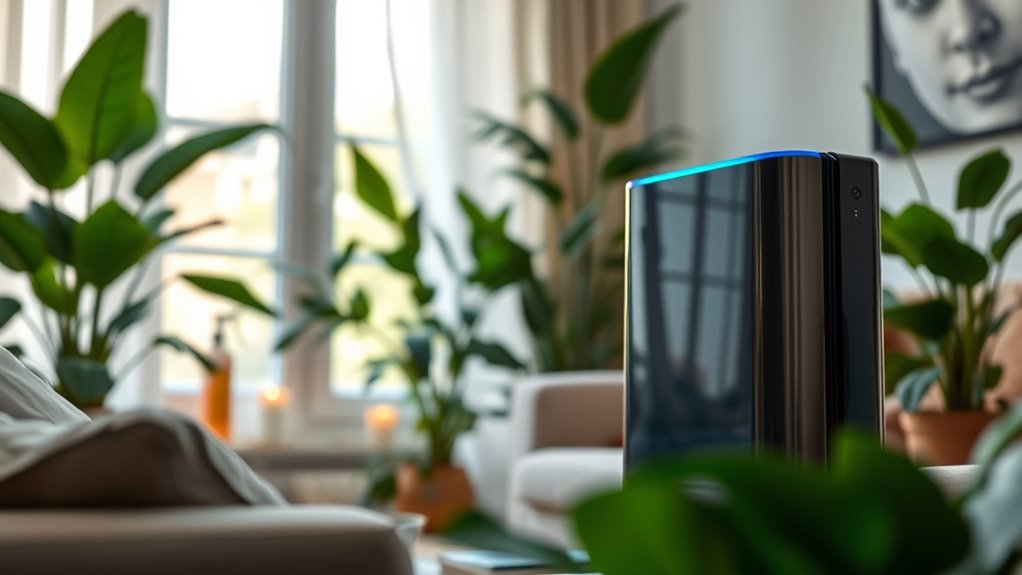
Many everyday environments contain airborne chemicals that can trigger sensitivities, making it important to identify common sources. Indoor plants, while adding beauty and humidity, can sometimes release volatile organic compounds (VOCs) from soil or fertilizers, affecting air quality. Household cleaning products, paints, and air fresheners also emit chemicals that can cause reactions. Gas stoves and fireplaces release combustion byproducts, further polluting indoor air. To better understand your air quality, using air quality monitors helps detect elevated chemical levels. Recognizing these sources allows you to take steps to reduce exposure. Simple adjustments, like choosing low-VOC products or monitoring indoor air, can make a significant difference in managing symptoms. Being aware of these triggers empowers you to create a healthier living environment. Additionally, understanding the importance of air purification can help mitigate the impact of these airborne chemicals on sensitive individuals. For example, the weight of wind turbine blades demonstrates how advanced materials are used to improve performance while reducing environmental impact, similar to how high-efficiency air purifiers can effectively remove pollutants from indoor air. Moreover, recent advances in AI-driven air quality monitoring systems enable more precise detection and management of indoor pollutants.
How Air Purifiers Capture and Remove Pollutants

Air purifiers work by actively drawing in polluted air and trapping harmful particles before releasing cleaner air back into your space. The efficiency of an air purifier depends on its ability to remove a wide range of airborne chemicals and pollutants quickly and effectively. Chemical removal mechanisms primarily involve activated carbon filters, which adsorb volatile organic compounds (VOCs) and other chemical vapors. Some purifiers use additional technologies like photocatalytic oxidation or specialized filters to enhance chemical removal. As air passes through these filters, harmful chemicals are captured and neutralized, reducing your exposure. Proper maintenance, such as regular filter replacement, guarantees ideal air purifier performance. Understanding Glycolic Acid Benefits and how they relate to skin health can help you choose devices that minimize skin irritation caused by airborne pollutants. Additionally, selecting filters with activated carbon ensures more effective removal of chemical vapors. Incorporating air purifier maintenance practices can prolong device lifespan and ensure optimal chemical removal. By understanding these mechanisms, you can choose a device that best suits your needs for safer, cleaner indoor air.
Types of Filters and Technologies Suitable for Chemical Sensitivity
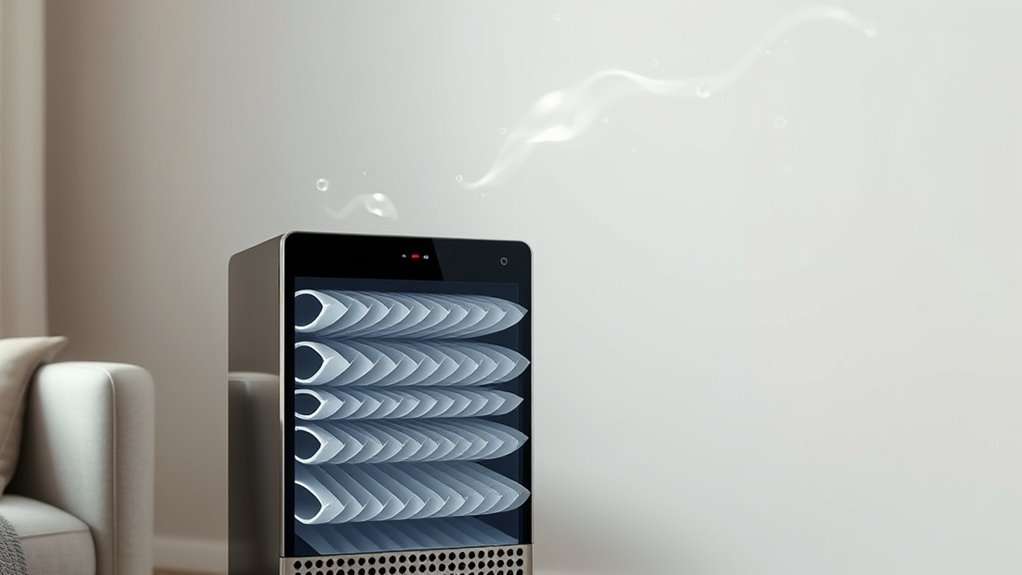
When choosing filters and technologies for chemical sensitivity, it’s essential to prioritize options that effectively target volatile organic compounds (VOCs) and chemical vapors. HEPA filters are excellent for capturing airborne particles like dust, pollen, and mold spores, but they don’t remove VOCs. That’s where activated carbon filters come in—they absorb chemical vapors and odors, making them indispensable for chemical sensitivity. Combining HEPA filters with activated carbon creates a thorough system that filters both particles and gases. Understanding cookie categories helps users make informed choices about their browsing preferences and privacy. Look for air purifiers that use both technologies in tandem for the best results. This combination helps reduce the presence of harmful chemicals in your environment, providing relief and improving indoor air quality for sensitive individuals. Additionally, choosing units with multi-stage filtration can enhance overall effectiveness by addressing various types of contaminants simultaneously.
Key Features to Consider When Choosing an Air Purifier
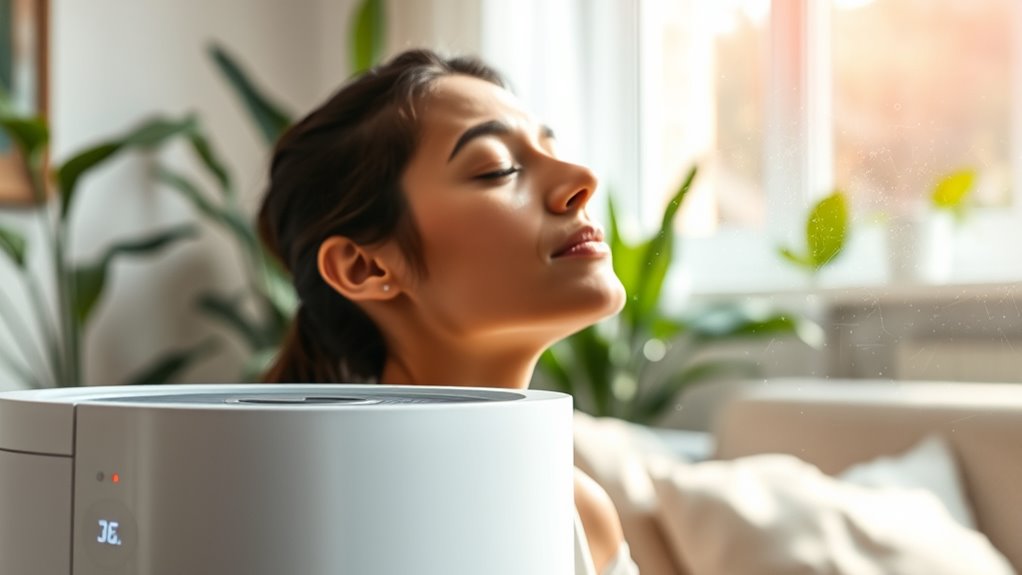
Choosing the right air purifier involves more than just selecting a model with the right filters. Look for features like air quality sensors that automatically adjust fan speed based on real-time conditions, ensuring cleaner air without constant manual control. Consider models that integrate with smart home systems for convenience. Indoor plants can complement your purifier by naturally improving air quality, so choose devices that work well alongside them. Also, check for adjustable settings and quiet operation to suit your environment. Durability and ease of maintenance are key, especially if you want consistent performance. Prioritize units with clear indicators for filter replacements and performance, so you stay informed. Additionally, understanding the automation in business can help you select devices that adapt to your lifestyle needs. These features help you create an ideal, safe indoor environment tailored to your chemical sensitivities. Regular filter maintenance, such as filter replacement, is essential for optimal performance and long-term effectiveness. Incorporating models with air quality sensors ensures your purifier responds dynamically to changing indoor conditions, maintaining optimal air quality effortlessly. Moreover, advancements like the Snapdragon 8 Gen 3 demonstrate how AI integration can enhance device capabilities and user experiences.
Benefits of Using Air Purifiers for Sensitive Individuals
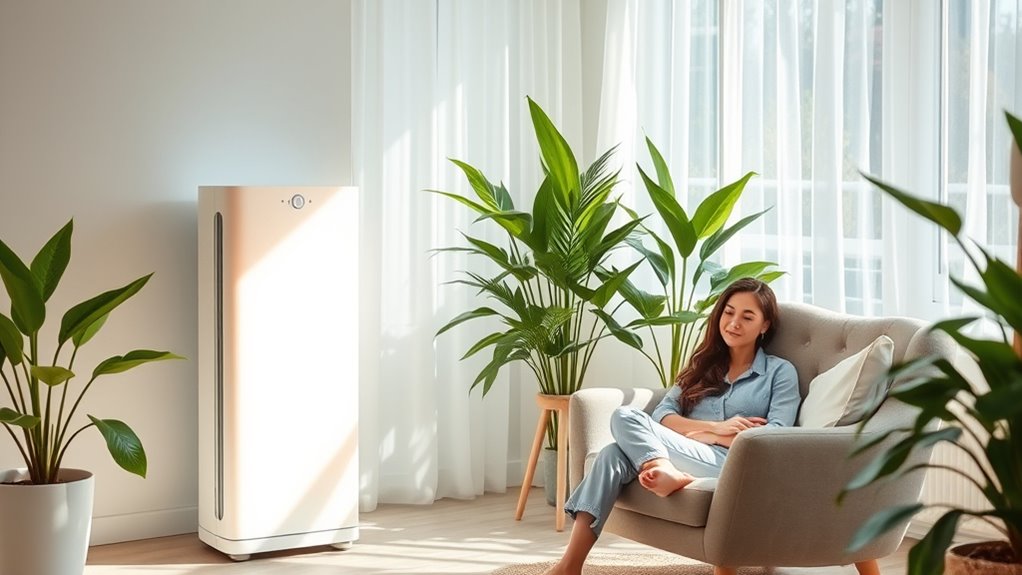
For individuals with chemical sensitivities, using an air purifier can substantially improve indoor air quality and reduce exposure to irritants. This helps minimize chemical reactions triggered by pollutants, which often worsen symptoms. By filtering out volatile organic compounds (VOCs), odors, and airborne irritants, your air purifier creates a cleaner environment, making symptom management easier. Reduced irritant levels can lead to fewer headaches, respiratory issues, and skin reactions. Proper use of an air purifier allows you to breathe more comfortably and feel more in control of your environment. Additionally, understanding personal growth and wellness strategies can empower you to better manage your health and environment. Incorporating advanced filtration technology, such as HEPA filters and activated charcoal, can further enhance your purifier’s effectiveness. Using air quality monitoring devices can help you track pollutant levels and adjust your purifier settings accordingly, ensuring optimal performance. Regular maintenance and filter replacement are also essential to maintain air purifier efficiency and ensure ongoing protection. Overall, investing in a quality air purifier supports your efforts to create a healthier living space, decreasing the frequency and severity of reactions caused by chemical sensitivities.
Tips for Optimal Placement and Usage of Air Purifiers
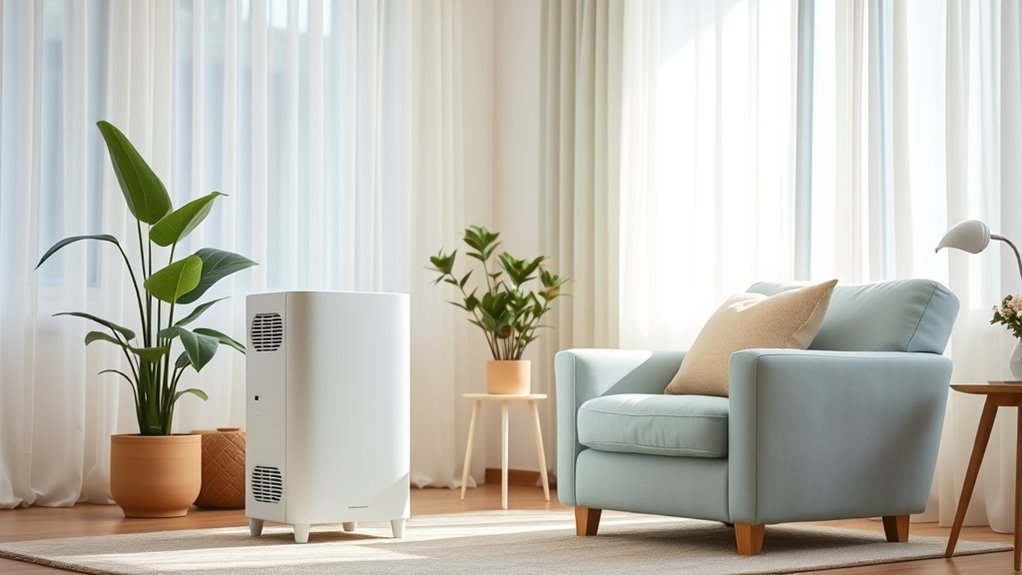
To get the most out of your air purifier, you need to place it in the right spot. Consider positioning it where it can circulate air effectively without obstructions, and keep it clean with regular filter maintenance. Proper placement and care guarantee your purifier works efficiently and provides cleaner air for your sensitive environment. Additionally, selecting an air purifier with appropriate filtration tailored for allergy or chemical sensitivities can enhance its effectiveness. Being aware of potential AI vulnerabilities and ensuring your devices are secure can prevent malfunctions that might affect your air quality. Incorporating comfort solutions like quiet operation features can also improve your overall experience and support a peaceful, healthy environment. Regularly monitoring air quality indicators can help you optimize your purifier’s performance and ensure a healthier indoor space. Moreover, choosing an air purifier with user-friendly controls makes routine adjustments easier, ensuring consistent air quality management.
Ideal Location Strategies
Placing your air purifier in the right spot can substantially enhance its effectiveness in reducing chemical sensitivities. Keep it away from indoor gardening areas, where plants release pollen and VOCs that could overwhelm the purifier. Instead, position it in high-traffic or central locations where air circulates most. Use air quality monitoring devices to identify areas with the highest pollutant levels, guiding your placement choices. Avoid placing the purifier near windows or vents that can cause drafts, reducing efficiency. Elevate it slightly off the floor for better airflow, especially if your space has carpeted areas. Proper placement ensures maximum coverage, helping to clear chemical pollutants more effectively and creating a healthier environment for sensitive individuals. Recognizing angel number soulmates can also inspire a sense of hope and connection in your journey toward health and well-being. Additionally, paying attention to website performance metrics can help you optimize your space and ensure your air purifier operates at peak efficiency. Regular maintenance and timely filter replacements are essential for maintaining optimal air purifier performance, ensuring your environment remains as free from pollutants as possible. To further enhance the purifier’s effectiveness, consider air circulation strategies such as using fans or vents to improve airflow throughout your space. Incorporating air filtration technology can also improve overall air quality and help remove a broader range of chemical contaminants.
Maintenance and Filter Care
Regular maintenance and proper filter care are essential to keeping your air purifier working effectively, especially when targeting chemical sensitivities. You should regularly check and replace filters according to the manufacturer’s instructions to guarantee peak performance. Keep indoor plants nearby, as they can enhance air quality and support your purifier’s efforts. Use air quality sensors to monitor your environment and adjust your purifier’s settings accordingly. Clean pre-filters frequently to prevent buildup and maintain airflow. Avoid placing your purifier near sources of pollution or in cramped spaces that hinder circulation. Proper placement and timely filter changes maximize the purifier’s ability to remove airborne chemicals and improve your overall indoor air quality, providing relief from sensitivities. Silly tantrums often occur during family photoshoots, adding humor to the moments.
Maintenance and Upkeep for Continued Effectiveness
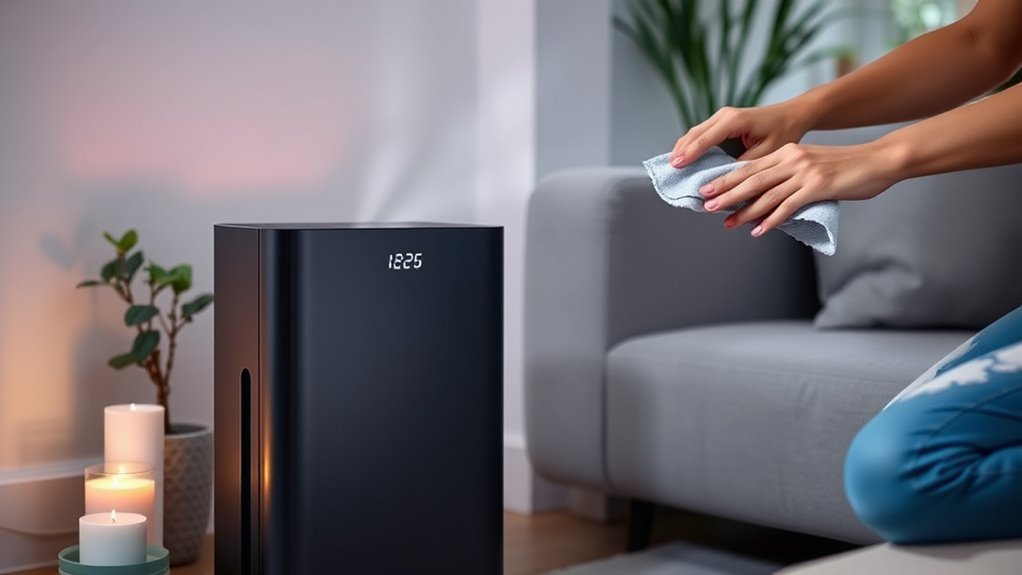
Maintaining your air purifier is essential to guarantee it continues to effectively remove chemicals from the air. Regularly adhering to your maintenance schedule ensures peak performance. Be proactive about filter replacement; a dirty filter reduces purification efficiency and can worsen sensitivities. Follow the manufacturer’s recommended timeline for filter changes, typically every 3 to 6 months. To keep your device running smoothly, clean external surfaces and check for any signs of wear. Proper upkeep extends the lifespan of your purifier and maintains its ability to filter harmful chemicals effectively.
- Set reminders for filter replacement to avoid delays
- Keep an eye on indicator lights signaling maintenance needs
- Regularly inspect for dust buildup or damage
- Record maintenance activities to track performance over time
Additional Strategies to Reduce Chemical Exposure at Home
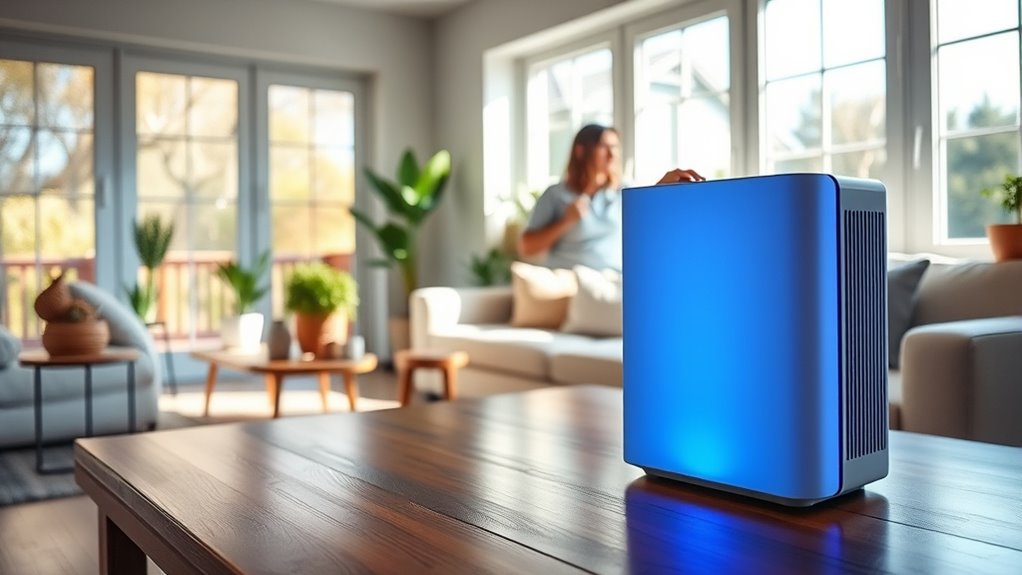
To further reduce chemical exposure at home, consider using natural, non-toxic cleaning products instead of conventional chemicals. This simple switch minimizes airborne toxins and creates a healthier environment. Incorporate indoor plants, which naturally filter airborne pollutants and improve air quality. You can also explore natural remedies like vinegar or baking soda for cleaning needs. To help you choose, here’s a quick comparison:
| Method | Benefits | Examples |
|---|---|---|
| Indoor Plants | Air purification, aesthetic appeal | Snake plant, pothos |
| Natural Cleaning | Reduces chemical exposure, eco-friendly | Vinegar, baking soda |
| Natural Remedies | Safer alternative, multi-purpose uses | Lemon, essential oils |
These strategies, combined with your air purifier, enhance your efforts to create a low-toxicity home environment.
Real-Life Stories and Testimonials of Improved Well-Being

Many people have experienced personal healing journeys after using air purifiers, finding relief from chemical sensitivities. These stories highlight how daily comfort improves and environmental challenges become easier to manage. Hearing about their experiences can inspire you to take steps toward better well-being.
Personal Healing Journeys
For individuals with chemical sensitivities, personal stories often highlight how air purifiers have transformed their lives. You might find that improved air quality offers more than relief; it can spark a journey of healing and self-discovery. Many discover that combining air purification with holistic therapies enhances their well-being. Emotional support from loved ones or support groups provides strength during setbacks. These journeys often include small victories, like increased energy or reduced reactions, fueling hope and resilience. Your experience may inspire others facing similar challenges, emphasizing the importance of tailored approaches. By sharing these stories, you realize that healing involves both physical comfort and emotional balance, creating a foundation for a more comfortable, empowered life.
Enhanced Daily Comfort
Personal stories reveal how air purifiers have directly enhanced daily comfort for individuals with chemical sensitivities. Many notice a significant difference in their environment’s air quality, making everyday activities more enjoyable. For example, incorporating indoor plants alongside air purifiers improves overall well-being. Regular air quality testing helps confirm improvements, reducing symptoms and stress. Here’s a snapshot of real experiences:
| Person | Change Observed | Tools Used |
|---|---|---|
| Sarah | Less headaches, clearer air | Air purifier, indoor plants |
| Mark | Improved sleep quality | Air quality testing |
| Lisa | Reduced allergic reactions | Air purifier |
| James | Less environmental smell | Indoor plants, testing |
These stories illustrate how tailored solutions create a more comfortable, healthier daily environment.
Overcoming Environmental Challenges
Stories from individuals who have faced environmental challenges demonstrate how effective use of air purifiers and other strategies can considerably improve well-being. Many find that adding indoor plants helps naturally filter air and boost mood, complementing UV sterilization to eliminate germs. These improvements create a safer, more comfortable environment, allowing you to breathe easier and reduce symptoms. Personal experiences reveal that combining air purifiers with lifestyle adjustments makes a significant difference.
- Using indoor plants enhances natural air filtration.
- UV sterilization reduces airborne pathogens.
- Creating a clean, allergen-free space boosts confidence.
- Consistent use of these strategies fosters a healthier environment.
Frequently Asked Questions
Are Air Purifiers Effective Against All Types of Chemical Sensitivities?
You might wonder if air purifiers work against all chemical sensitivities. While they excel at chemical filtration and VOC removal, not all models target every irritant. Some purifiers are designed specifically for certain chemicals, so check their filters and capabilities. For broad protection, choose an air purifier with HEPA and activated carbon filters. This combo effectively reduces many airborne chemicals, helping you breathe easier despite sensitivities.
How Often Should Filters Be Replaced for Optimal Performance?
You should replace your air purifier filters regularly to maintain ideal performance. Check the manufacturer’s guidelines, typically every 3 to 6 months, but adjust based on usage and air quality. Regular filter replacement ensures your device efficiently removes pollutants and allergens, especially important if you’re chemically sensitive. Staying consistent with filter replacement keeps the air clean and helps your air purifier work effectively to protect your health.
Can Air Purifiers Remove Odors Caused by Chemicals?
Think of your air purifier like a detective, hunting down chemical smells. It can effectively remove odors caused by chemicals when you maintain it properly. Regular air purifier maintenance, including timely filter replacement, guarantees it captures airborne chemicals and odors efficiently. For chemical smell removal, choose a purifier with activated carbon filters, as they excel at absorbing and neutralizing stubborn chemical odors, keeping your environment fresh and safe.
Do HEPA Filters Target Chemical Vapors Effectively?
HEPA filters are highly effective at capturing airborne particles like dust, pollen, and pet dander, but they don’t target chemical vapors directly. For chemical absorption, look for air purifiers with activated carbon filters, which excel at removing chemical odors and vapors. So, while HEPA effectiveness is great for allergens, you’ll need a carbon filter to effectively target chemical vapors and improve indoor air quality.
Are There Specific Brands Recommended for Chemical Sensitivity?
When choosing an air purifier, you want brand recommendations that focus on allergy-friendly options. Look for brands known for their high-quality filters, like Molekule or Blueair, which are often recommended for chemical sensitivity. These brands use advanced filtration technologies that help remove airborne chemicals and allergens, making your environment safer. Always check product reviews and certifications to verify the purifier suits your specific needs and provides effective protection.
Conclusion
By choosing the right air purifier, you’re fundamentally opening a gentle window to a calmer, more comfortable space. It acts like a soft breeze clearing away invisible shadows, allowing fresh air to breathe life into your environment. With mindful placement and regular care, you create a sanctuary where chemical sensitivities fade into the background. Embrace these small changes, and you’ll find your home transforming into a peaceful refuge, whispering comfort with every breath you take.
